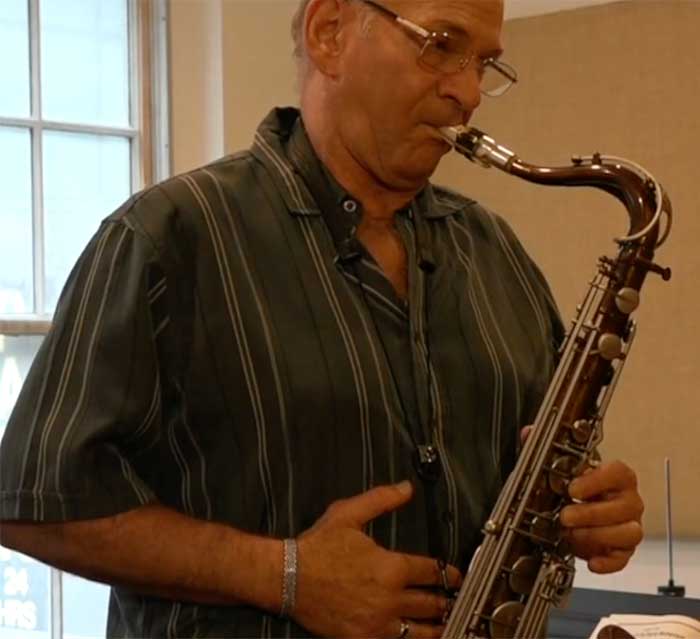How to Use Breath Support to Fatten Your Sound and Fix Intonation

To anyone who’s ever played a wind instrument, the advice to use proper air support is not exactly “insider information”. We’ve all heard it before, many times.
Over the course of my years on the saxophone, I certainly have been advised to “support the air from the diaphragm” , but I have to admit – for a long time, I didn’t know the exact reason that breath support mattered so much.
A Game-Changing Revelation
Some time ago, I had the privilege of a private lesson with the great altoist, Will Vinson (here’s a link to an ancient interview I did with him many years ago). I told him that I was struggling with a thin and shrill quality in my upper register, to which he dryly replied, “you do realize you play the alto saxophone(?)“.
In addition to his reassuring and hilarious response to my admission of upper-register challenges, upon watching me play, he shed some light on my above-the-staff woes by pointing out that I wasn’t taking very big breaths in between phrases. And I’ve come to find out that the size of my breaths was at the heart of my problem.
The “Garden Hose Method” of Breath Support

To illustrate the importance of maximizing my breath support, Will offered me the best analogy I’ve heard on the topic to date, and it goes a little something like this…
Let’s say you have a hose with a weak flow of water that isn’t traveling very far. Now, one way to make that water shoot out farther would be to partially cover the opening at the end of the hose with your thumb – and that does get the water moving out a bit farther. But, although the water is indeed traveling farther, you’ll notice that the flow is also unfocused, since your thumb is causing it to splinter into two or more separate trajectories.
The better way to provide the desired water pressure is to, of course, simply have a stronger and more focused flow of water coming out of the pipes in the first place, so that you don’t need to compromise its power and accuracy using the thumb on the hose hack.
“Thanks for the gardening lesson, but how does this apply to my playing?“
And the answer to that question can be found in our tendency to pinch the mouthpiece more and more as we move up to those notes at the upper end of the horn’s register. So because those higher notes require more air power, our lower jaw is, in effect, acting like a thumb on the garden hose.
Don’t “Thumb Your Hose” at Proper Air Support
Just like the boosted water flow from the obstructed opening at the end of the hose, when we artificially boost the air pressure by clamping down on the mouthpiece, it’s as though our sound is getting splintered, resulting in a less focused tonal quality. On top of that, the added pressure from the jaw dampens the vibration in the reed, making for a “thinner” sound that’s devoid of the diverse array of overtones and partials that make for that big and rich saxophone sound we all strive for.
And if all of that wasn’t enough, adding to our unfortunate smorgasbord of tonal issues is poor intonation, as the tightened jaw for the upper register notes brings the pitch up excessively in proportion to the octave below.
Transferring Your Energy
One concept that’s been quite helpful to me has been thinking of taking any energy that I am using in my jaw to clamp down, and transferring that energy to my diaphragm/air flow. That might sound sort of odd, but thinking about it this way allows me to keep the jaw pressure for the upper register more or less the same as it would be for the octave below, with the main difference being the slight rolling in of the lip for the higher notes and vice versa for the lower.
The Result
Once you’re in the habit powering those high notes with air volume rather than air constriction, you’ll find that your sound in the upper register is:
- bigger and “richer” as a result of the reed being freed up to allow for more overtones/upper partials
- more in tune
- more consistent in timbre to the lower register, giving you an added level of evenness of sound
On top of that, you’ll find that you are able to play for longer without your jaw muscles getting tired out.
“Three-Part Breathing” Explained and Demonstrated
One way to add air support is a technique known as “Three-Part Breathing”, and I’ll leave it to one of the world’s foremost experts on the topic of saxophone sound production to teach you that – none other than the legendary Dave Liebman.
The links below will take you to an intro as well as a demonstration of this method, which is a progression of simple exercises you can do with each practice session to increase the amount of available air behind your sound.
The following videos are taken from Liebman’s course, The Ultimate Guide to Saxophone Sound Production, which in my (totally unbiased but honest as the course’s publisher’s) opinion, is, literally, the best video course on the subject you will find anywhere.
Conclusion
So by now, hopefully you have a better understanding of why it is that we’re told to “support from the diaphragm” and in watching the videos above, have a new technique for doing just that.
So I encourage you to take this information to heart, and to the shed, and see for yourself just how much you can “fatten” your sound and fix your intonation with killer air support!
Looking to put the concepts in this article into practice?
Between now and December 14th at 11:59 PM PST, I’m offering a special holiday, extra-deep 40% discount on David Liebman’s game-changing course, Ultimate Guide to Saxophone Sound Production.
Click here to get the 40% discount (which you can also get by entering the coupon code, FATSOUND at checkout).







Favorite blog posts, December 2022 | Bret Pimentel, woodwinds
December 31, 2022 @ 11:00 am
[…] Best. Saxophone. Website. Ever. (Doron Orenstein): How to Use Breath Support to Fatten Your Sound and Fix Intonation […]